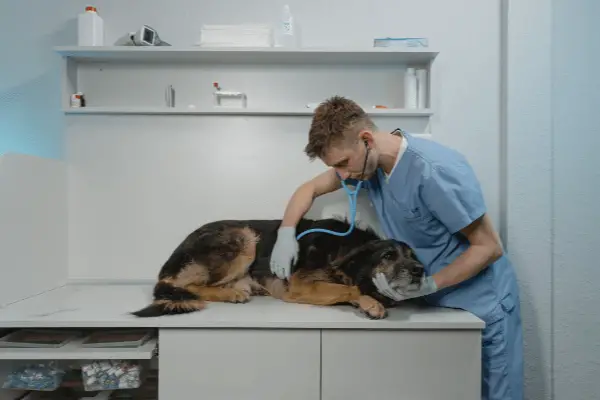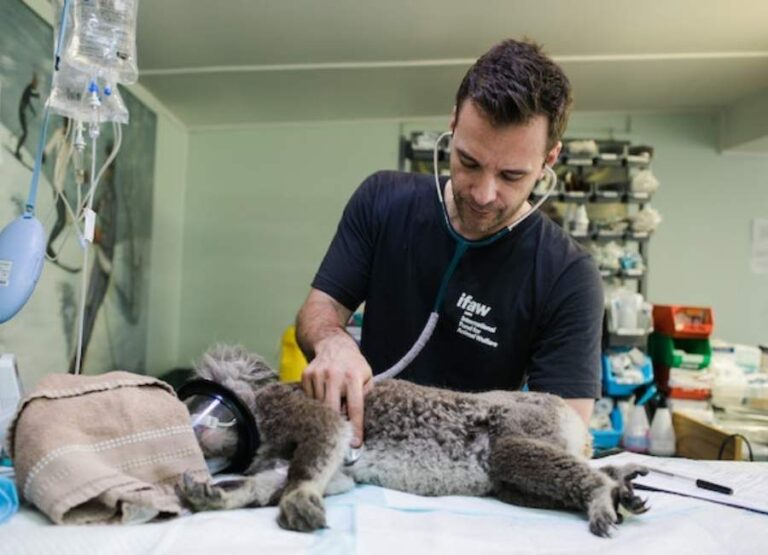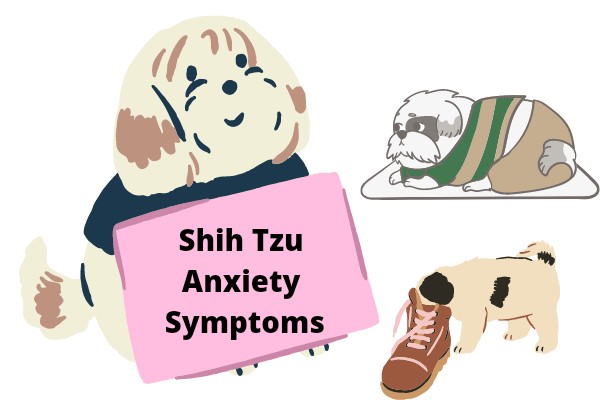15 Common Dog Sick Symptoms Not To Ignore

As a dog owner, it’s very important to know some of the most common dog sick symptoms as this can help save you money, time, and emotional breakdown.
Early identification of any illness in dogs can lead to proper health care and managing such illness, keep that in mind.
From my years of experience living with multiple dogs, I will be discussing the most common dog sick symptoms you should know, so keep reading.
Common dog sick symptoms
Here are some of the most common dog sick symptoms you should never overlook:
1. Frequent lethargy

Sluggishness, weakness, or dullness in dogs are all indicators of lethargy, and they’re easy to recognize.
Lethargic dogs may refuse to go for a walk, play, or eat, despite the fact that it is one of their favorite pastimes.
Keep an eye on your dog’s lethargy, whether it’s full or partial, and take him to the vet if things continue the way it is.
Dogs who are sedentary like to sit and lie down and do not respond to your calls, this circumstance may be a bit different.
Also Read: How to comfort a dying dog.
2. Reduced appetite
Anorexia nervosa can be seen in dogs to be a disorder in which a dog loses his or her appetite and is unable or unwilling to eat.
Appetite loss in dogs can be caused by a variety of illnesses, and it’s usually the first sign of a more serious problem.
If a dog’s lack of appetite persists for more than 24 hours, it may be hazardous to his or her health, and you should see the veterinarian immediately to find out why.
It’s important to remember that most pups lose their appetite before they reach the age of eight months; this isn’t necessarily a sign of disease.
Sick dogs always have a reduced appetite to eat, therefore when your dog who loves mealtimes start holding back you need to pay attention.
3. Sudden changes in temperaments

When a dog is in discomfort he or she will exhibit behavioral changes such as reduced activity, lethargy or outgoing nature may begin to retreat.
Observe whether your dog growls when you approach a certain place of the body that may be causing discomfort, some sick dogs can become very aggressive.
When a dog is unwell, not all of them will behave badly; some dogs may become clinging or exhibit symptoms of heightened neediness.
Additional signs to watch for include a lack of appetite, stomach discomfort, vomiting, diarrhea, lameness, and straining to pee.
Contact a professional veterinarian if you observe any major changes in your dog’s behavior or other symptoms.
4. Persistent coughing
Coughing is a common defense reaction in dogs that prevents aspiration by clearing fluids or foreign items from the throat, vocal cords, and/or airways.
Honking noise might signal a disorder called tracheal collapse, which is frequent in particular dog breeds, and it affects the respiratory system, making breathing difficult for dogs.
An infrequent cough should be properly examined and investigated if it does not disappear or is accompanied by other symptoms.
All dogs with coughs should consult a veterinarian, especially if the cough is persistent because certain coughs in dogs can be fatal.
5. Sudden self-isolation from favorite activities

One of the most common signs of a sick dog is self-isolation from favored activities; while this may be unpleasant for some dog owners, understanding your dog’s need for seclusion is crucial.
When a dog is unwell, the majority of breeds want to be left alone since they have lost interest in everything and are in agony.
It’s a clue that your dog is unwell if he keeps going away from family members, activities, or sounds to a quiet location.
If your dog used to run up to you and pursue the ball, but now he isn’t interested in pursuing the ball or running up to you, there is something wrong that needs to be addressed.
6. Excessive Licking
Depending on where your furry buddy is focused her attention, this dog symptom may signify something different.
Licking between her claws, hips, or near her tail on a regular basis might indicate an allergy or other skin problem.
If she licks the floor or her mouth repeatedly, she may have a gastrointestinal problem; consult your veterinarian to be sure.
7. Frequently vomiting
Most common cause of repeated vomiting in dogs is poor judgment on the part of their owners.
Frequent vomiting might be a sign of a dangerous or even life-threatening medical problem that needs immediate medical attention and a veterinarian’s diagnosis.
In most dogs, vomiting can occur when the contents of the stomach and upper intestines are forced out.
Excessive vomiting on a daily basis is a common symptom of dog sickness.
If your dog vomits more than once a day, without a break, or for more than 24 hours, you should take him to the veterinarian.
8. Lashes or Itchy skin
Patches, little flaky patches, or acne-like red lumps emerge suddenly on a dog’s skin and lashes, indicating that irritation is an indication of skin problems.
A bothersome, uncomfortable sensation that causes your dog to scratch is also referred to as this. Your dog’s body might be harmed in any way.
The coat of a dog should be thick, lustrous, and velvety. Something isn’t quite right if your coat is drab, scratchy, dry, or has bald spots.
A bad diet, an allergy, or a skin condition might all be to blame. A trip to the veterinarian is necessary in any case.
Itchy skin is one of the most common signs of illness in dogs, and it can be caused by a number of things.
9. Persistent weight loss
Weight loss is one of the most common and well-known dog sick symptoms.
To put it a simple way, the dog burns more calories than it consumes.
Dogs suffer from weight loss, which is mostly caused by a calorie deficiency.
When a dog eats and/or releases critical nutrients quicker than it can absorb them, this happens.
When a dog’s weight loss surpasses 10% of their usual body weight and is not accompanied by fluid loss, it is deemed clinically serious.
Even if your dog is overweight, abrupt weight loss should cause you to visit the veterinarian. Rapid and sudden weight loss might signify a major health problem.
Bring it to your veterinarian’s notice if your dog’s weight lowers by 10%. This might be as low as a one-pound weight decrease in tiny dogs.
10. Increased water consumption or reduction
It’s crucial to know how much water your dog consumes on a daily basis since this will assist you determine any increases or decreases.
You can tell whether your dog is developing renal disease or diabetes if he consumes more water than normal.
If you have to replace the water bowl more frequently than usual, your dog is drinking too much water.
If they have an excessive volume of pee, need to go outdoors more frequently, or have accidents in the home, on the other hand.
11. Difficulty passing poop or pee
There’s a medical explanation if your well-trained dog hasn’t had an accident in the home in a long time and is suddenly making a lot of messes.
Accidents, trouble passing a bowel movement, diarrhea, difficulty urinating, or significant changes in the frequency or volume of urine should not be disregarded if they continue more than a few days.
Some of these symptoms in older dogs are particularly concerning, as they might indicate a renal problem.
12. Runny eyes or nose
Sneezing, panting, runny eyes and nose, or other flu-like symptoms, as well as gasping or shortness of breath, are all markers of respiratory difficulties.
Squinting, cloudy or red eyes, or excessive discharge from your dog’s eyes might all be signs of illness or damage.
Make sure you take your dog in for a checkup as soon as possible, keep in mind that conditions of the eyes can advance quickly and result in blindness.
Medication can be used to treat an infection or ease clinical symptoms, but you must first consult with a veterinarian.
13. Changes in the color of dogs gum
Gum disease is indicated by reddened or swollen gums, especially when they are accompanied by poor breath.
When the condition is severe, dogs may lose teeth, drop food from their jaws, and lose weight as a result of their inability to eat.
Lifting the lip and inspecting the gum tissue is the best approach to determine your dog’s gum color. Gums in normal dogs are pink and wet.
Dogs with pale gums might be anemic or be in shock. All of the probable reasons are potentially dangerous.
It’s a medical emergency if your dog’s gums are pale, he’s sluggish, weak, or has difficulties breathing.
For immediate medical assistance, contact your veterinarian or the nearest veterinary emergency facility.
14. Continuous fluctuations in body temperature
Fluctuations in body temperature or fever, which may be detected by owners, are thought to be one strategy for dogs to combat illness.
In reaction to an incursion of foreign substances such as germs or viruses, the dog’s physiology readjusts the brain’s temperature control zone to elevate body temperature.
If you touch your dog’s belly area, you will always find aberrant body temperature, which should be between 98.9 and 102.5 degrees Fahrenheit.
If your dog’s temperature is too high or too low, seek expert help from your veterinarian.
15. Sudden and persistent diarrhea
A change in nutrition, getting into the garbage, viral or bacterial diseases, motion sickness, parvovirus in pups, or ingestion of a foreign item can all induce sudden diarrhea.
Your dog has diarrhea if there are any variations in the feces, such as the presence of blood or mucous.
Please call your veterinarian and bring a new stool sample with you if symptoms recur numerous times in 24 hours and are linked with weakness, lethargy, lack of appetite, or unproductive vomiting.


![Head Trauma in Dogs [Signs, Causes & Treatment] Head Trauma in Dogs](https://petcreeks.com/wp-content/uploads/2023/12/pexels-mikhail-nilov-7469230.jpg)



